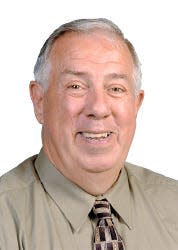Some dust leaves columnist recalling ‘The Grapes of Wrath’
- Oops!Something went wrong.Please try again later.
- Oops!Something went wrong.Please try again later.
You know, recently, some folks woke up in our community and discovered an unknown dust on their vehicles. Many were taken aback by this event as it seemed quite unusual and suspicious.
Like those unidentified flying balloons floating high in the sky, now an unseen menace is discovered on far too many cars. "What could it be?" circulated throughout the neighborhood.
I begin thinking about David Lee Murphy’s popular hit, "Dust on the Bottle."

Do you remember the line Creole Williams says as he "reached through the cobwebs"?
"There might be a little dust on the bottleBut don't let it fool ya about what's insideThere might be a little dust on the bottleIt's one of those things that gets sweeter with time"
I love that song and could sing the whole thing for you.
And then I begin to think more seriously, about John Steinbeck’s "The Grapes of Wrath," and his story about a far more dangerous dust.
'It looked like it was snowing': Search on for source of dust that coated parts of region
In watching the "America: The Story of Us" on the History Vault, I learned much about the Dust Bowl, the name given to a drought in the 1930s. It was one of the many major issues that confronted President Franklin Roosevelt.
The Dust Bowl affected the southern Plains of our country. The rains stopped coming to this region and serious consequences occurred. The Great Depression, happening at the same time, only added misery to the pain.
Severe dust storms with high winds were a serious impediment, and a loss of human lives and livestock were common occurrences as this plague swept from Texas to Nebraska.
Steinbeck pens a fictional story of the Joad family from Oklahoma, hard hit by the Dust Bowl and Great Depression, and searching for some relief in their migration to California with hopes of prosperity.
Their many hardships are vividly described.
Steinbeck, too, paints an interesting picture reflecting the circumstances of this period in our history for the Dust Bowl migrants.
There were several things contributing to the Dust Bowl chapter of our history beyond just the lack of rain.
One was the Homestead Act of 1862, which provided settlers with 160 acres of public land for farming. This act, along with later federal government programs, sent many who were inexperienced in farming procedures out West to farm.
Many experts thought the Great Plains were the ideal place to make riches off of farming. But these novice farmers were soon tearing up the land to sell the world their wheat crops. With the major drought beginning in 1931, these over-plowed acres now provided an oasis for disaster.
"Eroding soil led to massive dust storms and economic devastation — especially in the Southern Plains," writes the History Channel in its recounting of this period, which lasted a decade. "During these years, severe dust storms, often called 'black blizzards,' swept the Great Plains."
The History Channel narrative continues: "On May 11, 1934, a massive dust storm two miles high traveled 2,000 miles to the East Coast, blotting out monuments such as the Statue of Liberty and the U.S. Capitol."
Around that time, roughly 35 million acres of formerly fertile farmland could not be farmed, the narrative states. Another 125 million acres, "an area roughly three-quarters the size of Texas," was losing topsoil quickly.
The rains did not return until 1939, finally ending the Dust Bowl and that calamity that affected so many lives across our nation.
Steinbeck captures all of this in his Pulitzer Prize-winning novel, which was later made into an award-winning movie staring Henry Fonda, Jane Darwell and John Carradine.
While I was thinking of the confusion over the recently arrived dust in our community, my mind went drifting back to reading Steinbeck’s classic.
History will always remember "The Grapes of Wrath," but what about out mini Dust Bowl, which ultimately left some particles on a few cars?
Time will tell.
Pete Waters is a Sharpsburg resident who writes for The Herald-Mail.
This article originally appeared on The Herald-Mail: Strange substance found on cars recently brings to mind Steinbeck
